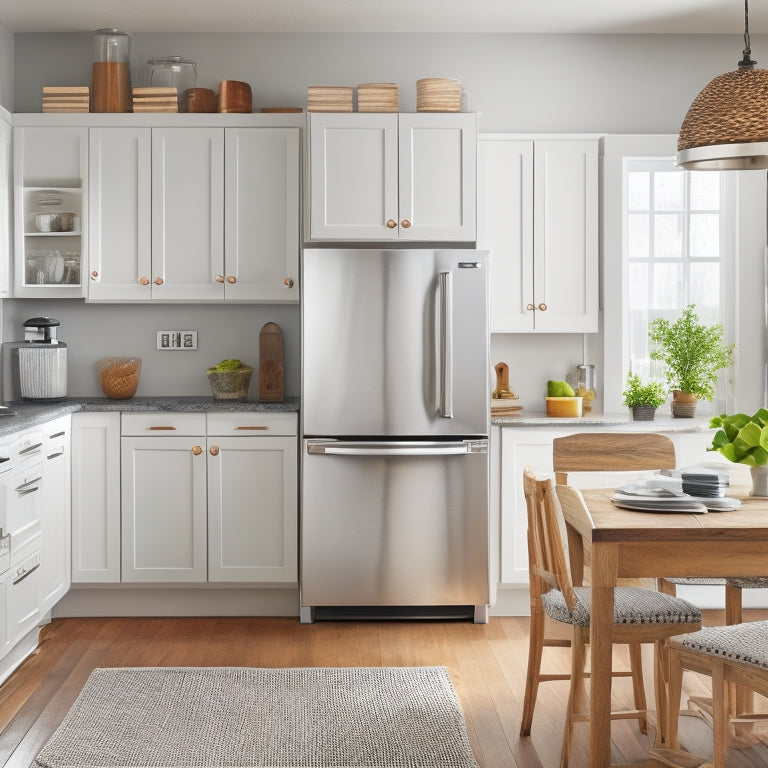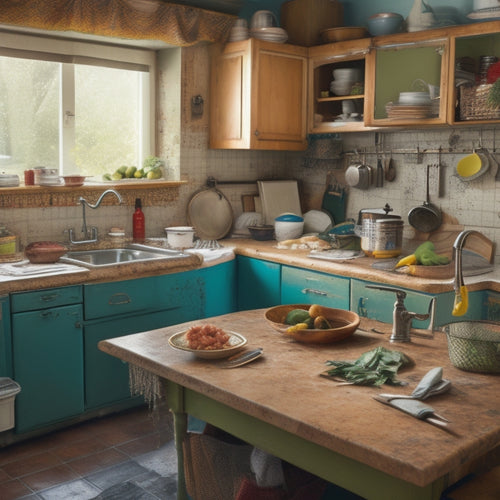
5 Essential Tips for Organizing a Small Kitchen
Share
To maximize your small kitchen's potential, start by purging and decluttering items you no longer need. Then, optimize your storage spaces by thinking vertically and utilizing the back of cabinet doors. Next, designate zones for efficiency, assigning specific areas for food prep, cooking, and cleanup. You'll also want to utilize vertical storage options like hanging baskets and wall racks to free up counter space. Finally, implement a maintenance routine to keep your kitchen organized and clutter-free. By following these essential tips, you'll be well on your way to creating a functional and peaceful kitchen space, and there's even more to discover.
Key Takeaways
• Purge and declutter kitchen items, sorting them into keep, donate, and discard categories, and being ruthless about items not used in a year.
• Optimize kitchen storage spaces by thinking vertically, utilizing the back of cabinet doors, and maximizing functionality with smart design.
• Designate zones for efficiency by dividing the kitchen into food prep, cooking, and cleanup areas, and storing utensils and appliances accordingly.
• Utilize vertical storage options like hanging baskets, wall racks, and magnetic boards to maximize storage capacity in a small kitchen.
• Implement a maintenance routine with daily, weekly, and monthly tasks to keep the kitchen organized and clutter-free.
Purge and Declutter Kitchen Items
Start by gathering boxes, trash bags, and a willingness to let go, because it's time to purge and declutter your kitchen items, freeing yourself from the chaos that's been hindering your cooking flow. You'll be amazed at how much space you can create by getting rid of items you no longer need or use.
Begin by sorting items into categories: keep, donate, and discard. Be ruthless – if you haven't used it in the past year, it's probably safe to let it go. Donate unused items to a local charity or thrift store, and toss anything broken or beyond repair.
Next, turn your attention to your pantry. Organize pantry shelves by grouping similar items together, such as baking supplies, canned goods, and snacks. Remove any expired or stale items, and wipe down shelves before restocking. Consider using baskets or bins to store dry goods like pasta, rice, and grains.
Optimize Kitchen Storage Spaces
Now that you've purged and decluttered your kitchen items, it's time to optimize your kitchen storage spaces by assigning a home for each item, making the most of every available inch. This is where creative organization and space saving solutions come into play.
Think vertically by installing shelves, hooks, or a pegboard to maximize your wall space. Utilize the back of a cabinet door by adding a spice rack, a magnetic board, or a storage basket.
To maximize functionality, focus on smart design. Consider a Lazy Susan in a corner cabinet or a slide-out drawer to make items easily accessible. Use baskets, bins, and containers to store similar items together, making them easy to grab when needed.
Don't forget about the often-wasted space above your cabinets – add a few decorative storage containers or a wine rack to make the most of it. By implementing these strategies, you'll be able to fit more into your small kitchen while keeping it organized and functional.
Designate Zones for Efficiency
By dividing your small kitchen into designated zones, you'll create a workflow that streamlines food preparation, cooking, and cleanup, making the entire process more efficient. This strategic approach will help you maximize space and boost workflow efficiency.
Identify the key areas of your kitchen, such as food prep, cooking, and cleanup, and assign a specific zone for each. This will enable you to move seamlessly from one task to the next, reducing clutter and confusion.
Designate a zone for food prep, where you'll store utensils, ingredients, and appliances needed for meal prep. The cooking zone should be centered around your stove or cooktop, with pots, pans, and cooking essentials within easy reach. The cleanup zone should be near the sink, with cleaning supplies and dishware storage.
Utilize Vertical Storage Options
In a small kitchen, where every inch counts, making the most of your walls and ceilings with vertical storage options becomes a game-changer for maximizing storage capacity and keeping countertops clutter-free. By installing shelves, hooks, and racks, you can create additional storage space without sacrificing floor space.
Here are some effective ways to utilize vertical storage options:
-
Hanging baskets: Suspend them from the ceiling to store infrequently used items like special occasion dishes or cookbooks.
-
Wall racks: Install them to hang pots, pans, utensils, or even a pegboard for frequently used items.
-
Magnetic boards: Use them to store spices, oils, or frequently used ingredients within easy reach.
- Step shelves: Create a tiered storage system for canned goods, cookbooks, or decorative items.
Implement a Maintenance Routine
You've optimized your kitchen's storage capacity, but to keep your space organized and clutter-free, you need to establish a regular maintenance routine that tackles messes as they happen.
This routine should include daily, weekly, and monthly tasks to maintain order and prevent clutter from building up. Daily tasks might include wiping down countertops, putting away dishes, and tidying up after meals.
Weekly tasks could include cleaning the fridge, oven, and stove, as well as sweeping and mopping the floors.
Monthly tasks might involve deep cleaning high-traffic areas, reorganizing storage spaces, and checking expiration dates of food items.
Frequently Asked Questions
How Do I Deal With Cluttered Kitchen Countertops?
You tackle cluttered kitchen countertops by implementing decluttering strategies like categorizing items, purging unused gadgets, and assigning homes for essentials, then utilize organization hacks like installing shelves or a utensil organizer to keep everything in its place.
Can a Small Kitchen Still Have a Functional Island?
You can still have a functional island in a small kitchen by considering island alternatives, like carts or tables, and creative layouts that maximize space, allowing you to optimize workflow without sacrificing functionality.
Are There Any Space-Saving Appliances Available?
You'll find space-saving appliances that fit your needs, such as compact refrigerators, microwaves, and dishwashers. Look for multi-functional solutions like toaster oven combos or induction cooktops that maximize functionality while minimizing footprint.
How Often Should I Deep Clean My Small Kitchen?
You should deep clean your kitchen every 1-2 months, depending on usage, to maintain a hygienic space. Regular maintenance is key, especially in a small kitchen where clutter and grime can quickly accumulate, affecting the overall layout and decor.
Can I Still Have a Kitchen Desk or Office Area?
You can definitely have a kitchen desk or office area, but you'll need to get creative with organizing paperwork and utilizing wall space to keep the area clutter-free and functional.
Related Posts
-

Why Kitchen Renovation Demands a Meal Planning Strategy
As you prep for your kitchen renovation, you'll quickly realize that the absence of a meal planning strategy is a rec...
